<< Previous | Displaying results 6601-6625 of 6769 for "" | Next >>
Some of the nursing staff of the "euthanasia" clinic at Hadamar stand outside of the institution after the arrival of US forces, April 5, 1945. Irmgard Huber, the head nurse of the clinic, is probably the person standing fifth from the right. © IWM EA 62183
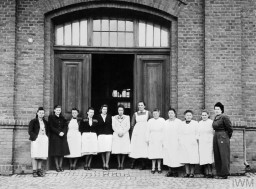
Runners competing in the 800-meter race at the Olympic games in Berlin. In this photograph, American John Woodruff is just visible in the outside lane. He came from behind to win the race in 1:52.9 minutes. Source record ID: 95/73/12A.
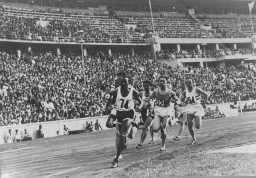
Cigarette card portraying some of the American track and field athletes who competed in the 1936 Olympics in Berlin, Germany. The US team was the second largest to compete in the 1936 Summer Olympic Games with 312 members, including 18 African Americans. Cigarette cards were collectible cards often included in packages of cigarettes into the 1940s.
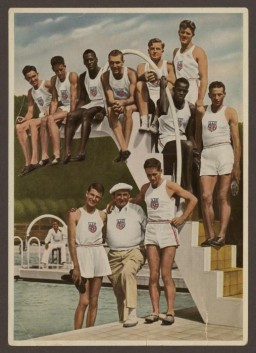
African American athletes Jesse Owens and Dave Albritton pose with a German citizen. They both competed in the 1936 Olympic Games. Albritton won the silver medal in high jump. Owens won gold medals in the 100-meter dash, 200-meter dash, broad (long) jump, and the 4x100-meter relay.
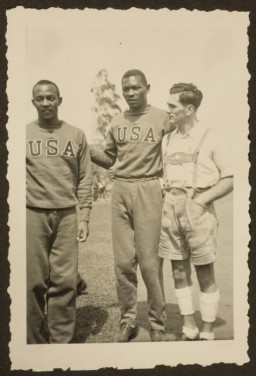
African American athlete Archie Williams competed in the 1936 Berlin Olympic Games. He won the gold medal in the 400-meter race. The US team was the second largest to compete in the 1936 Summer Olympic Games with 312 members, including 18 African Americans.
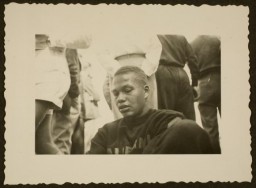
Portrait of Janusz Korczak, a Polish Jewish doctor and author who ran a Jewish orphanage in Warsaw, circa 1930.
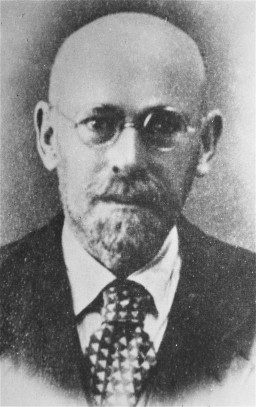
Janusz Korczak (center) and Sabina Lejzerowicz (to his right) pose with children and younger staff in Korczak's orphanage in Warsaw, circa 1930-1939. Even as they were deported to their deaths at Treblinka in 1942, Korczak and his staff stayed by their children.
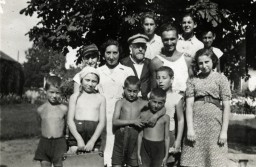
A wall sculpture memorializing Polish Jewish doctor Janusz Korczak resides on the exterior of a teaching hospital that bears his name, Olsztyn, Poland.
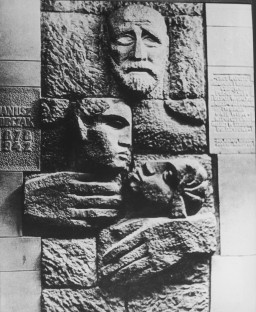
Exterior view of the Jewish orphanage run by Janusz Korczak. Established in 1912, the orphanage was located at 92 Krochmalna Street in Warsaw, Poland. Photo taken circa 1935.
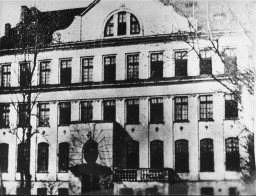
In this Nazi propaganda picture, young German children are shown eating a meal. The original caption reads: "Everything for the healthy child." Photo dated 1933–1943.
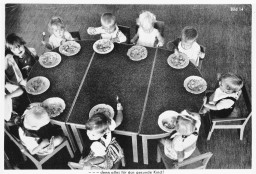
Two photos showing the exterior and interior views of a Lebensborn home, circa 1933–1943.

Photograph of two of the Tehran Children, who reached Palestine in 1943 via Iran.

SS troops stand at attention for inspection, Germany, 1936-1939. This photo is from an album of SS photographs.
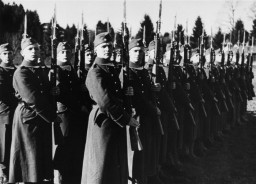
Propaganda poster depicting two Germans in the field during World War II. After the war began in 1939, Police Battalions were deployed alongside the German military. This poster was designed by SS-Hauptsturmführer Felix Albrecht in 1941.
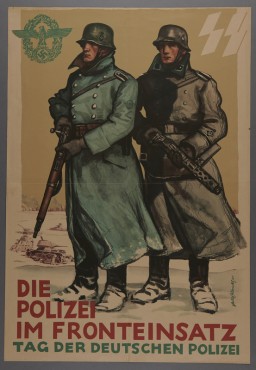
Bernhardt Colberg, a member of Reserve Police Battalion 101, poses in front of its headquarters in the vicinity of Lodz in German-occupied Poland. The police battalions were units of the German Order Police who were deployed to German-occupied areas of Europe during World War II. Photo dated 1940–1941.
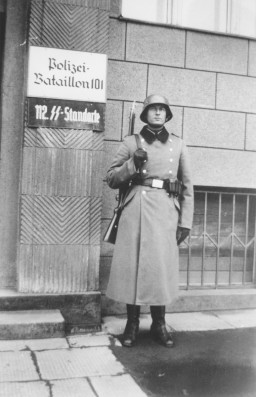
Members of the German Order Police publicly humiliate a group of Jews by forcing them to perform exercises, 1939–1940. Sosnowiec, in German-occupied Poland.
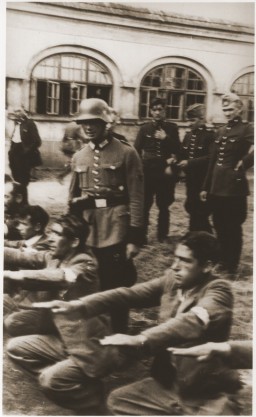
Members of the German Order Police stand guard over a group of Orthodox Jewish men, 1942. The men have been rounded-up either for forced labor or public humiliation. Krakow, in German-occupied Poland.
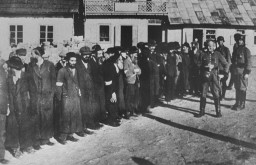
A member of the German Order Police raises a stick to beat a Jew who is loading his bundles onto a wagon during expulsion from the community of Sieradz in German-occupied Poland. Photo dated 1940–1942.
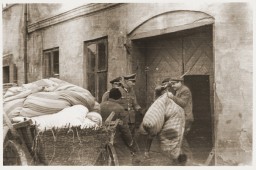
German policemen search an elderly, religious Jew at gunpoint in German-occupied Poland, circa 1941.
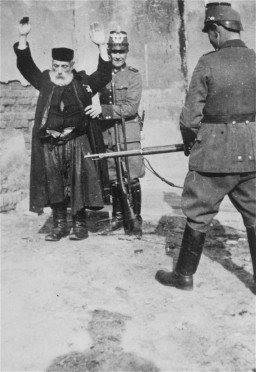
German Order Police officers inspect members of Police Battalion 101 in Lodz after the German occupation of Poland, 1939–1943.
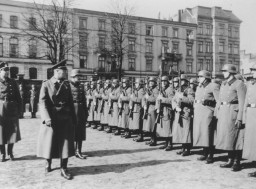
The Kracowski family was living in Bialystok when German Order Police Battalion 309 killed 2,000-3,000 Jews on June 27, 1941. Dr. Samuel Kracowski was among the hundreds of Jews locked in the Great Synagogue and burned alive. After the Germans ordered the establishment of a ghetto in Bialystok, Samuel's wife, Esther, and children, Ewa and Julek, were given a room in the ghetto clinic. Photo dated September 1, 1935. Samuel and Esther are seated in the center, with Julek seated in the front row on the…

A member of the German Order Police Battalion 101 stands next to a sign marking the entrance to the Lodz ghetto in German-occupied Poland, 1940–1941. The German text of the sign reads: "Announcement: In accordance with a police order of February 8, 1940, all Germans and Poles are forbidden entry into the ghetto area."
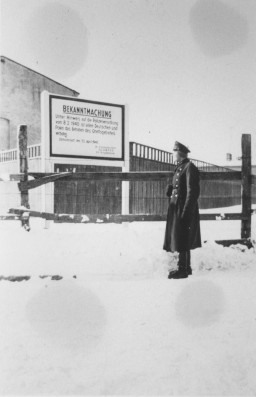
Nazi eugenics poster entitled "Feeble-mindedness in related families in four neighboring towns." This poster shows how "feeble-mindedness" and alcoholism are passed down from one couple to their four children and their families. The poster was part of a series entitled, "Erblehre und Rassenkunde" (Theory of Inheritance and Racial Hygiene), published by the Verlag für nationale Literatur (Publisher for National Literature), Stuttgart, Germany, ca. 1935.
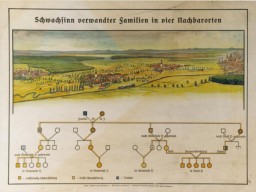
Propaganda slide produced by the Reich Propaganda Office showing the opportunity cost of feeding a person with a hereditary disease. The illustration shows that an entire family of healthy Germans can live for one day on the same 5.50 Reichsmarks it costs to support one ill person for the same amount of time. Dated 1936. Nazis defined individuals with mental, physical, or social disabilities as “hereditarily ill” and claimed such individuals placed both a genetic and financial burden upon society…
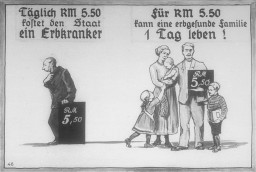
In July 1995, Bosnian Serb forces killed as many as 8,000 Bosniaks from Srebrenica. It was the largest massacre in Europe since the Holocaust. This photograph shows a Bosniak woman at a makeshift camp for people displaced from Srebrenica in July 1995.
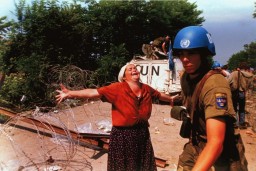
We would like to thank Crown Family Philanthropies, Abe and Ida Cooper Foundation, the Claims Conference, EVZ, and BMF for supporting the ongoing work to create content and resources for the Holocaust Encyclopedia. View the list of donor acknowledgement.